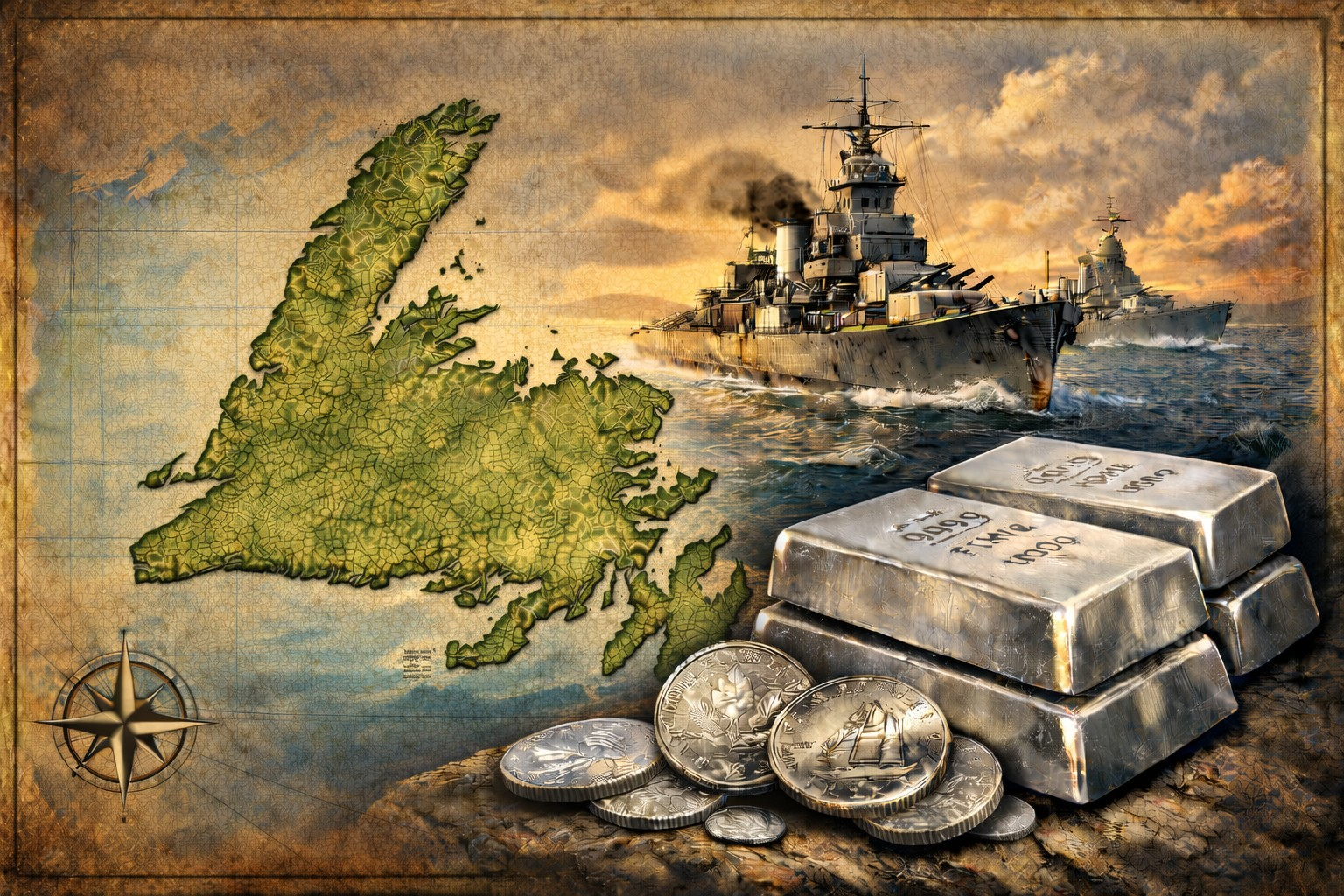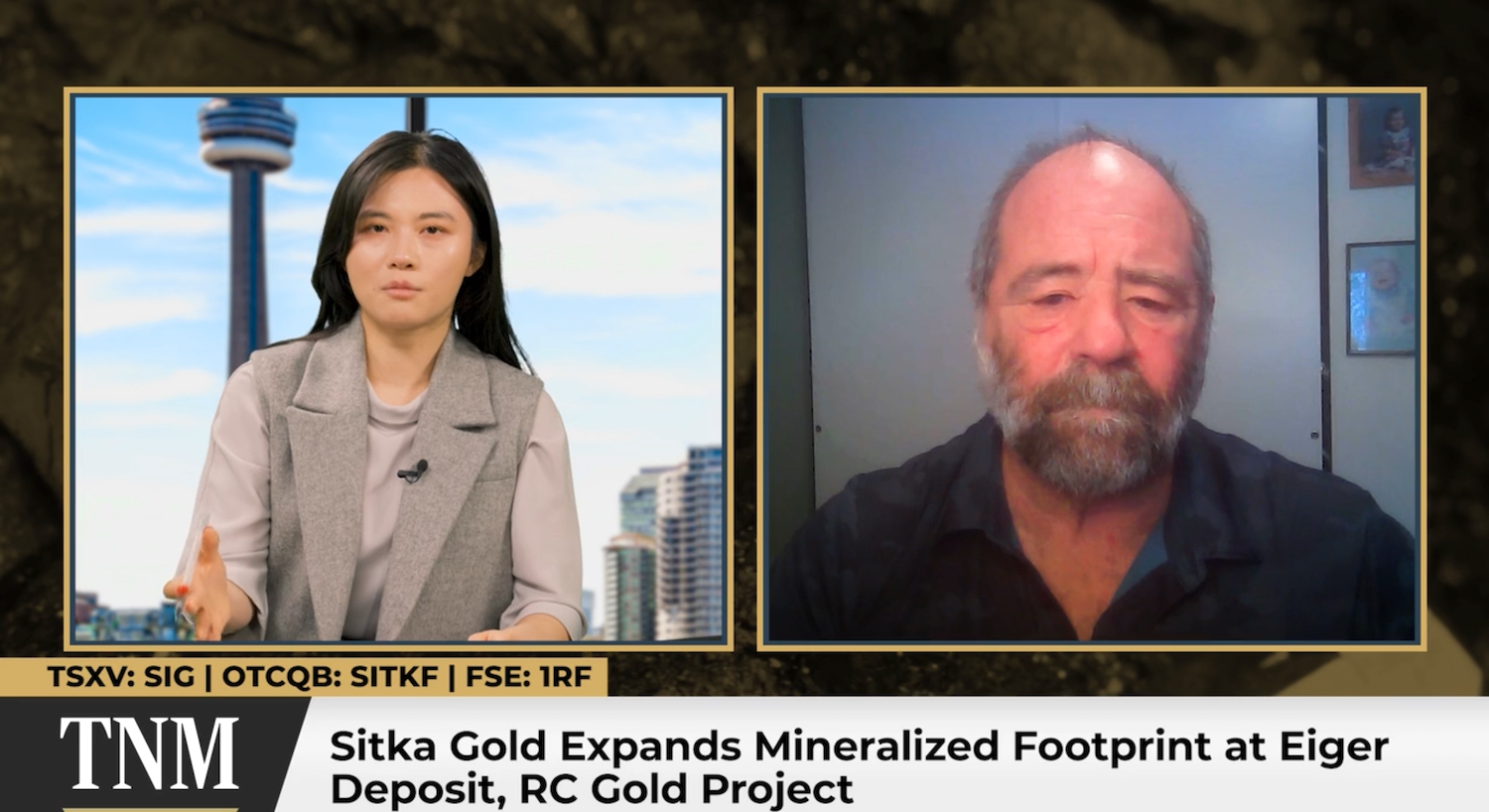In mid-November, CopAur reported an assay result of 15.3 grams gold per tonne over 32.3 metres from 254.5 metres depth, from the Western Flank Zone at Kinsley. The interval included a higher-grade section of 24.1 grams gold over 10.7 metres.
Assay results reported a week earlier from three reverse-circulation (RC) holes targeting the property’s Main Pit North zone included 0.51 gram gold over 13.7 metres from 129.5 metres depth and 0.42 gram gold over 7.6 metres from 114.3 metres.
The oxide intercepts define an emerging zone of mineralization extending 150 metres outside the current resource pit shell, Copaur said in a release. The results reaffirm its view that Main Pit North, along with its Secret Spot surface discovery, are key areas for oxide resource expansion at Kinsley Mountain, it added.
CopAur’s 2023 drill program included 19 RC holes totalling 2,300 metres and two diamond drill holes totalling 1,200 metres. The program included infill drilling at the high-grade Western Flank zone, and near surface oxide-gold expansion and delineation drilling at the Main Pit North oxide and Secret Spot targets. It also involved testing a new IP chargeability anomaly between the Western Flank Zone and the Upper Ridge Pit area.
Kinsley Mountain has a February 2020 resource estimate of 5 million indicated tonnes grading 2.63 grams gold per tonne for 418,000 oz. and 2.4 million inferred tonnes grading 1.51 grams gold for 117,000 oz.
CopAur acquired a 79.9% interest in Kinsley Mountain by fulfilling the requirements of an option agreement with Liberty Gold (TSX: LGD; US-OTC: LGDTF) in May 2022. A 20% interest in the property was held by Nevada Sunrise (TSXV: NEV; US-OTC: NVSGF), which has seen its stake diluted to 18.66% since it opted not to help fund this year’s drill program.
CopAur Minerals has a market capitalization of $21.3 million.
Delta Resources
Delta Resources (TSXV: DLTA; US-OTC: DTARF) recently completed a 20,000-metre drill program at its Delta-1 project, 50 km west of Thunder Bay, Ont.
The Kingston, Ont.-based company released the final assay results from the 48-hole campaign in November. Highlights included 5.92 grams gold per tonne over 31 metres, 2.06 grams gold over 65.8 metres and 2.16 grams gold over 97.5 metres.
Delta has the right to acquire a 100% interest in the 107-sq.-km property, which straddles the Trans-Canada Highway for a distance of 16 kilometres. Gold mineralization is defined over 1.8 km and to a vertical depth of 250 metres.
The current drill program ended in October, after which Delta completed a 37 line-km, 3-D induced-polarization survey covering 2.8 sq. km to better understand known mineralization and explore the extensions of the gold-bearing structure. Delta has also completed a televiewer probing survey on 14 drill holes to collect structural information on possible fault and vein orientations. A compilation of geological and geochemical data is under way. Delta plans to resume drilling in January.
The company closed a $10-million bought-deal financing in May and is fully financed with roughly $7 million in its treasury to fund its 2024 exploration.
In August, Delta paid $50,000 to Ontario Exploration Corp. to buy back the remaining 50% of a 1% net smelter return on Delta-1. It also said it would receive a $200,000 grant from the Ontario Junior Exploration Program.
The company was awarded the 2022 Bernie Schnieders Discovery of the Year Award from the Northwestern Ontario Prospectors Association for its Delta-1 project.
Delta also owns the Delta-2 gold-copper project 35 km southeast of Chibougamau, Que., and has a 1% net smelter royalty on the Bellechasse-Timmins gold property in Quebec’s Beauce region.
Delta Resources has a market capitalization of $9.9 million.
Freegold Ventures
Alaska-focused Freegold Ventures (TSX: FVL; US-OTC: FGOVF) is advancing its Golden Summit and Shorty Creek projects in the last frontier state.
In a Dec. 4 news release, Freegold announced highlights from its 2023 drill program at Golden Summit, located 32 km northeast of Fairbanks. In all, the company completed 44 holes totalling 26,000 metres. Hole GS2333 returned 4.25 grams gold over 67.1 metres from 438 metres depth and 4.09 grams gold over 24 metres from 608.3 metres depth.
Other results released in November and October included 1.44 grams gold over 31.4 metres from a depth of 278.6 metres downhole, and 1.05 grams gold over 164.3 metres from 425 metres, including 1.48 grams gold over 45.7 metres.
Once all of the results are received, Freegold intends to upgrade its February 2023 in-pit resource estimate. Golden Summit currently holds of 407.5 million indicated tonnes grading 0.92 gram gold per tonne for 12 million oz. and 282.3 million inferred tonnes at 0.85 grams gold for 7.7 million ounces.
The current resource estimate is restricted to the property’s Dolphin Cleary zone, where 37 of the 44 holes were drilled this year to test its boundaries, and expand and upgrade the resource. An additional seven holes were drilled at the property’s Saddle zone, just to the east of Dolphin Cleary.
The February resource, based on results from 131 holes totalling 83,000 metres of drilling in 2020 to 2022, reflected close to a 10-fold increase in indicated ounces.
Golden Summit is located 6 km north of Kinross Gold’s (TSX: K; NYSE: KGC) Fort Knox mine, which has produced more than 8 million oz. of gold overmore than 20 years of operation.
Freegold president and CEO Kristina Walcott says Golden Summit represents one of the largest undeveloped gold resources in North America.
At Freegold’s Shorty Creek copper-gold porphyry property, located 125 km northwest of Fairbanks exploration since 2014 has included ground geophysics, geochemical surveys and some diamond drilling. In its initial drill program in 2015, one hole intersected 91 metres grading 0.55% copper, 7.02 grams silver and 0.14 gram gold. Freegold has a market capitalization of $175 million.
GoldMining
Vancouver-based GoldMining (TSX: GOLD; NYSE: GLDG) is advancing several projects in five countries in the Americas.
In September, the company released an updated preliminary economic assessment (PEA) for its 100%-owned La Mina project in Colombia. The study estimates life-of-mine production at 1.7 million gold-equivalent ounces over11.2 years. Projected life-of-mine production includes 1.3 million oz. of gold, 203.9 million lb. of copper, and 3 million oz. of silver.
The PEA projects an after-tax NPV of US$279.5 million (at 5% discount rate), and an internal rate of return of 15.2% based on commodity prices of US$1,750 per oz. gold, US$21 per oz. of silver and US$3.50 per lb. of copper. Preproduction capex is estimated at US$424.8 million and total capex at US$628 million, including sustaining capital and closure costs.
Included in the mine plan is the recently discovered La Garrucha deposit for which the company announced an initial resource in January 2023. La Garrucha hosts 7.4 million tonnes grading 0.84 gram gold equivalent per tonne for 200,000 oz. of gold equivalent, plus 44.1 million inferred tonnes grading 0.72 gram gold equivalent for 1 million oz. gold equivalent.
“Compared to many copper porphyry deposits globally, La Mina has a high ratio of gold to copper and as such the feed grade at La Mina of 1.02 grams per tonne gold-equivalent is well above global averages,” Tim Smith, GoldMining’s vice-president of exploration said in a release. “La Mina also has the added advantages of being located in moderate topography with existing road and power infrastructure located just 40 km from the provincial capital city of Medellin.”
GoldMining controls a diversified portfolio of gold and gold-copper projects in Canada, the U.S., Brazil, Colombia and Peru. It also owns more than 21 million shares of Gold Royalty Corp. (NYSE: GROY), 9.8 million shares of U.S. Gold Mining (NASDAQ: USGO) and 16.6 million shares of NevGold Corp. (TSX: NAU).
GoldMining has a market capitalization of $228.5 million.
Great Boulder Resources
Great Boulder Resources (ASX: GBR), a Perth, Australia-based company is advancing three main projects in the state of Western Australia.
In November, it published an updated resource estimate for its flagship Side Well gold project near Meekathara, 756 km northeast of Perth.
Indicated resources now total 2.4 million tonnes grading 3.3 grams gold for 252,000 oz. and 4.1 million inferred tonnes grading 2.4 grams gold for 316,000 oz. for the property’s Mulga Bill deposit. For Side Well’s nearby Ironbark deposit, the resource outlined 753,000 indicated tonnes grading 3.7 grams gold for 88,000 oz. and 186,000 inferred tonnes grading 1.9 grams gold per tonne for 11,000 ounces.
Together, the two deposits account for 7.5 million tonnes with an average grade of 2.8 grams gold for 668,000 ounces.
The updated resource represents “a significant increase in contained ounces at Mulga Bill and Ironbark as well as the conversion of a large proportion of both deposits from the inferred to indicated JORC category,” noted Great Boulder managing director Andrew Paterson. The two deposits, he added, are now “defined with sufficient confidence to commence economic studies once the current inflationary cycle peaks and we can confidently predict future cost inputs.”
In late November, Great Boulder signed an option agreement to acquire up to 75% of Castle Minerals’ (ASX: CDT) Poelle and Wanganui gold projects at Meekatharra, doubling the company’s footprint there to 384 sq. km.
It also Great Boulder secured binding commitments to raise A$4.5 million ($4 million) in a placement to support the expansion of Side Well.
Drilling last year at Side Well included 157 air core holes for 14,111 metres and 114 RC and diamond-drill holes for 21,299 metres. Another 49,382 metres were drilled prior to 2023 for a total of 70,680 metres.
In August, Great Boulder entered into a joint venture with Wanbanna Pty over eight prospecting licences immediately south of Side Well, giving it access to more than 5 km of strike extensions to the Ironbark stratigraphy. With the staking of four other prospecting licences in the area, the Side Well project now covers 145 sq. km of ground and more than 30 km of continuous strike extent.
Great Boulder’s portfolio also includes the Whitehead gold project, 40 km north of Kalgoorlie, and the Wellington zinc-lead project, 150 km east of Wiluna. Whitehead is an amalgamation of two exploration agreements concluded in 2019. The eastern half of the project is a joint venture with Zebina Minerals and the western half is subject to a farm-in agreement with Mithril Resources (ASX: MTH).
Great Boulder has a market capitalization of A$28.4 million.
Magnetic Resources
Magnetic Resources (ASX: MAU) is developing a portfolio of deposits at its Laverton project in the namesake mining district of Western Australia.
The latest resource for Laverton, released in November, reported 10.4 million indicated tonnes grading 1.74 grams gold per tonne for 584,400 oz. and 12.2 million inferred tonnes of 1.65 grams gold for 651,300 ounces. The project is located 360 km northeast of Kalgoorlie.
The new resource totalling 1.2 million oz. represents a 107% increase of total ounces over a February 2023 estimate.
Magnetic’s Laverton project consists of a cluster of deposits, including Hawks Nest 9, Lady Julie Central, Lady Julie North 4, Mount Jumbo and Homeward Bound South. The company says the key deposits are close to each other.
The update was based on recent infill and down-dip drilling primarily at Lady Julie North 4, where contained gold increased to 852,000 oz. from 204,000 ounces.
“The Lady Julie North 4 resource… has multiple stacked lodes with a number of thick intersections that have not been closed off at depth,” Magnetic managing director George Sakalidis said in a release. Initial deeper drilling at Lady Julie North 4 started in January 2023 and was then expanded to a 95-hole RC drill program of more than 16,350 metres.
Lady Julie North now has the largest resource in the project area. Continued drilling at depth is expected to further grow the resource, which currently accounts for 69% of the project’s indicated and inferred ounces.
The deposit sits within a regional structure called the Chatterbox Shear zone that extends over a 12-km distance within Magnetic’s landholdings.
Environmental, heritage and technical background studies are close to being completed. Magnetic expects to submit a mining proposal early this year.
Magnetic Resources has a market capitalization of A$249 million.
Montage Gold
Montage Gold (TSXV: MAU; US-OTC: MAUTF) is developing its advanced Koné gold project in northern Côte d’Ivoire.
In late November Montage said it was almost finished its environmental and social impact assessment for Koné, and expected to received approvals by the first quarter of this year.
The most recent resource estimate for Koné, released in September, outlined 237 million indicated tonnes grading 0.63 gram gold per tonne for 4.8 million oz. and 22 million inferred tonnes grading 0.45 gram gold for 320,000 oz.
The updated resource benefits from the higher-grade Gbongogo Main satellite deposit. It adds an indicated resource of 12 million tonnes grading 1.45 grams per tonne gold for 559,000 oz. at a cut-off grade of 0.5 gram per tonne,deposit based on close to18,400 metres of drilling. The much larger, but lower-grade Koné deposit holds 225 million tonnes of 0.59 gram gold for 4.3 million oz. at a cut-off grade of 0.2 gram gold.
A feasibility study released in February 2022 projected a 14.8-year mine life, total gold production of 3.1 million oz., initial capex of $543.9 million and sustaining capital of $291.7 million.
The study, which Montage plans to update ahead of a development decision in early 2024, estimated an after-tax net present value of $746 million and as internal rate of return of 35%. The new study won’t include the Gbongogo Main deposit or the 2022 acquisition of the Mankono-Sissédogou joint venture from Barrick Gold (TSX: ABX; NYSE: GOLD) and Endeavour Mining (TSX: EDV; LSE: EDV) for $30 million ($14.5 million) in cash and shares. With the addition of Mankono, the Koné project land package increased to more than 2,250 sq. km.
The feasibility study Vancouver-based Montage intends to truck ore 35 km from the Gbongogo Main deposit to a mill adjacent to the Koné deposit.
“With the initial conversion of Gbongogo Main now completed we are on track to make a construction decision for the Koné gold project [and] are confident that the project will be fully permitted during the first half of 2024,” said Montage CEO Rick Clark in a September release.
Montage Gold has a market capitalization of $129.5 million.
Renegade Gold
Renegade Gold (TSXV: RAGE; US-OTC: TGLDD) holds a portfolio of projects in the Red Lake district of northwestern Ontario.
The Vancouver-based company said in September it was planning “an extensive, multi-phase work program” expected to start in late 2023 focused initially on its Newman Todd deposit in Red Lake.
Newman Todd hosts high-grade and widespread mineralization within a 2.2-km strike. It hosts a large, shallow, historic resource from 2015 of 350,000 indicated tonnes grading 2.76 grams gold per tonne for 31,000 oz. and 574,000 inferred tonnes grading 2.78 grams gold for 51,000 ounces. Gold mineralization is open in every direction with minimal drilling below 300 metres depth. Drill results at Newman Todd include one intercept of 129.79 grams gold over 1.3 metres, including 561 grams gold over 0.3 metre.
Renegade’s property covers more than 1,260-sq.-km in the Red Lake mining district adjacent to Evolution Mining’s (ASX: EVN) Red Lake mine, Kinross Gold’s (TSX: K; NYSE: KGC) Great Bear project, West Red Lake Gold Mine’s (TSXV: WRLG; US-OTC: WRLGF) Madsen mine and First Mining Gold’s (TSX: FF; US-OTC: FFMGF) Springpole project.
In June, Renegade, then known as Trillium Gold, acquired Pacton Gold, increasing its land holdings in Red Lake by 360 sq. km. Pacton’s work on its Red Lake project included 79 drill holes totalling more than 26,700 metres and 1,011 surface samples with assays of up to 126.5 grams gold per tonne. The combination left Trillium shareholders with a 53% stake in the combined company.
As part of the transaction, former Pacton interim president and CEO Nav Dhaliwal and former executive chairman Luke Norman joined the Trillium board. The company became Renegade Gold in July.
In addition to Newman Todd and the Pacton Gold Red Lake project, Renegade has a 46.7% stake in the 86-sq.-km Sidace joint venture project with Evolution Mining. Sidace is an advanced gold project with more than 80,000 metres of drilling, including 17 of 18 drillholes completed in 2020 and 2021 with intersections of gold mineralization.
In early December, Renegade received a 3-day extension to complete a $3-million private placement announced in late September. The cash will be used to extinguish debt, as well as for exploration and working capital.
Renegade Gold has a market capitalization of $6.5 million.



